Spectral and Photometric Studies of NGC 3516 in the Optical Range
Abstract
1. Introduction
2. Observatories, Telescopes and Equipment
2.1. Methodology of Photometric Analysis
2.2. Methodology of Spectral Analysis
3. Results
3.1. Results of Photometric and Spectral Studies of the Galaxy NGC 3516
3.2. Spectral Modeling
4. Discussion
5. Conclusions
Author Contributions
Funding
Informed Consent Statement
Data Availability Statement
Acknowledgments
Conflicts of Interest
Appendix A. Theoretical Background for Bayesian Analysis
| 1 | https://ned.ipac.caltech.edu (Access date: 6 November 2024). |
References
- Andrillat, Y.; Souffrin, S. Variations du Spectre du Noyau de la Galaxie de Seyfert NGC 3516. Astrophys. Lett. 1968, 1, 111–119. [Google Scholar]
- Shapovalova, A.I.; Popovic, L.C.; Afanasiev, V.L.; Ilic, D.; Kovacevic, A.; Burenko, A.N.; Chavushyan, V.H.; Marčeta-Mandić, S.; Spiridonova, O.; Valdes, J.R.; et al. Long-term optical spectral monitoring of a changing-look active galactic nucleus NGC 3516—I. Continuum and broad-line flux variability. Mon. Not. R. Astron. Soc. 2014, 485, 4790–4803. [Google Scholar] [CrossRef]
- Cherepashchuk, A.M.; Lyutyi, V.M. Rapid Variations of Halpha Intensity in the Nuclei of Seyfert Galaxies NGC 4151, 3516, 1068. Astrophys. Lett. 1973, 13, 165. [Google Scholar]
- De Rosa, G.; Fausnaugh, M.M.; Grier, C.J.; Peterson, B.M.; Denney, K.D.; Horne, K.; Bentz, M.C.; Ciroi, S.; Dalla Bontà, E.; Joner, M.D.; et al. Velocity-resolved Reverberation Mapping of Five Bright Seyfert 1 Galaxies. ApJ 2018, 866, 133. [Google Scholar] [CrossRef]
- Denney, K.D.; Peterson, B.M.; Pogge, R.W.; Adair, A.; Atlee, D.W.; Au-Yong, K.; Bentz, M.C.; Bird, J.C.; Brokofsky, D.J.; Chisholm, E.; et al. Diverse Kinematic Signatures from Reverberation Mapping of the Broad-Line Region in AGNs. Astrophys. J. 2009, 704. [Google Scholar] [CrossRef]
- Ilic, D.; Oknyansky, V.; Popovic, L.; Tsygankov, S.; Belinski, A.; Tatarnikov, A.M.; Dodin, A.V.; Shatsky, N.I.; Ikonnikova, N.P.; Rakić, N.; et al. A flare in the optical spotted in the changing-look Seyfert NGC 3516. Astron. Astrophys. 2020, 638, 7. [Google Scholar] [CrossRef]
- Popovic, L.; Ilic, D.; Burenkov, A.; Alvarez, V.M.P.; Marčeta-Mandić, S.; Kovačević-Dojčinović, J.; Shablovinskaya, E.; Kovačević, A.B.; Marziani, P.; Chavushyan, V.; et al. Long-term optical spectral monitoring of a changing-look active galactic nucleus NGC 3516. II. Astron. Astrophys. 2020, 675, 14. [Google Scholar] [CrossRef]
- Kraemer, S.B.; Crenshaw, D.M.; George, I.M.; Netzer, H.; Turner, T.J.; Gabel, J.R. Variable Ultraviolet Absorption in the Seyfert 1 Galaxy NGC 3516: The Case for Associated Ultraviolet and X-Ray Absorption. Astrophys. J. 2002, 577, 98. [Google Scholar] [CrossRef]
- Mathur, S.; Wilkes, B.J.; Aldcroft, T. The X-Ray Warm Absorber in NGC 3516. Astrophys. J. 1997, 478, 182. [Google Scholar] [CrossRef]
- Turner, T.J.; Kraemer, S.B.; George, I.M.; Reeves, J.N.; Bottorff, M.C. Complex X-Ray Absorption and the Fe Kα Profile in NGC 3516. Astrophys. J. 2005, 618, 155. [Google Scholar] [CrossRef]
- Ilić, D.; Popović, L.; Burenkov, A.; Shablovinskaya, E.M.E.U.R.; Moiseev, A.; Oparin, D.; Patiño Álvarez, V.; Chavushyan, V.; Marziani, P. Long-Term Optical Monitoring of Broad-Line AGNs (LoTerm AGN): Case Study of NGC 3516. Physics 2024, 6, 3. [Google Scholar] [CrossRef]
- Blandford, R.D.; McKee, C.F. Reverberation mapping of the emission line regions of Seyfert galaxies and quasars. Astrophys. J. 1982, 255, 419–439. [Google Scholar] [CrossRef]
- Urry, C.M.; Padovani, P. Unified Schemes for Radio-Loud Active Galactic Nuclei. Astron. Soc. Pac. 1995, 107, 803. [Google Scholar] [CrossRef]
- Mehdipour, M.; Kriss, G.A.; Brenneman, L.W.; Costantini, E.; Kaastra, J.S.; Branduardi-Raymont, G.; Di Gesu, L.; Ebrero, J.; Mao, J. Changing-look Event in NGC 3516: Continuum or Obscuration Variability? Astrophys. J. 2022, 925, 84. [Google Scholar] [CrossRef]
- Astronomical Imaging Software. Available online: https://diffractionlimited.com/product/maxim-dl/ (accessed on 6 November 2024).
- Doroshenko, V.; Sergeev, S.; Merkulova, N.I.; Sergeeva, E.A.; Golubinsky, Y.V.; Pronik, V.I. BVRI CCD Photometry of Comparison Stars in the Fields of 44 Active Galaxies. Astron. Soc. Pac. 2007, 360, 69. [Google Scholar]
- Shomshekova, S.A.; Reva, I.V.; Kondratyeva, L. Standardization of the photometric system of the 1-meter telescope on TSHAO. Natl. Acad. Sci. Repub. Kazakhstan-Phys.-Math. Ser. 2017, 4, 155–161. [Google Scholar]
- Fitzpatrick, M.; Placco, V.; Bolton, A.; Merino, B.; Ridgway, S.; Stanghellini, L. Modernizing IRAF to Support Gemini Data Reduction. arXiv 2024, arXiv:2401.01982. [Google Scholar] [CrossRef]
- Kharitonov, A.V.; Tereshchenko, V.; Knyazeva, L.N. Spectrophotometric Catalog of Stars, 3rd ed.; Kazakh University: Kazakhstan, Almaty, 2011; ISBN 9965-29-626-X. [Google Scholar]
- Schlafly, E.F.; Finkbeiner, D.P. Measuring Reddening with Sloan Digital Sky Survey Stellar Spectra and Recalibrating Sfd. Astrophys. J. 2011, 737, 103. [Google Scholar] [CrossRef]
- Speagle, J. Dynesty: A dynamic nested sampling package for estimating Bayesian posteriors and evidences. Mon. Not. R. Astron. Soc. 2020, 493, 3132–3158. [Google Scholar] [CrossRef]
- Koposov, S.; Speagle, J.; Barbary, K.; Ashton, G.; Bennett, E.; Buchner, J.; Scheffler, C.; Cook, B.; Talbot, C.; Guillochon, J.; et al. DYNESTY. 2023. Available online: https://zenodo.org/records/8408702 (accessed on 6 November 2024).
- Oknyansky, V.; Mikailov, K.; Huseynov, N. Changing Looks of the Nucleus of Seyfert Galaxy NGC 3516 during 2016–2020. Astron. Rep. 2020, 64, 979–984. [Google Scholar] [CrossRef]
- Oknyansky, V.L.; Brotherton, M.S.; Tsygankov, S.S.; Dodin, A.V.; Bao, D.W.; Zhao, B.X.; Du, P.; Burlak, M.A.; Ikonnikova, N.P.; Tatarnikov, A.M.; et al. Multi-Wavelength Monitoring and Reverberation Mapping of a Changing Look Event in the Seyfert Galaxy NGC 3516. Mon. Not. R. Astron. Soc. 2021, 505, 1029–1045. [Google Scholar] [CrossRef]
- Cann, J.M.; Satyapal, S.; Abel, N.P.; Ricci, C.; Secrest, N.J.; Blecha, L.; Gliozzi, M. The Hunt for Intermediate-mass Black Holes in the JWST Era. Astrophys. J. 2018, 861, 142. [Google Scholar] [CrossRef]
- Rodriguez-Ardila, A.; May, D.; Panda, S.; Fonseca-Faria, M.A.; Fraga, L. The narrow-line region properties of ESO 138-G001 unveiled by SOAR/SIFS observations. Mon. Not. R. Astron. Soc. 2024, 527, 10649–10667. [Google Scholar] [CrossRef]
- Callow, J.; Graur, O.; Clark, P.; Palmese, A.; Aguilar, J.; Ahlen, S.; BenZvi, S.; Brooks, D.; Claybaugh, T.; Macorra, A.d.; et al. The rate of extreme coronal line emitting galaxies in the Sloan Digital Sky Survey and their relation to tidal disruption events. Mon. Not. R. Astron. Soc. 2024, 535, 1095–1122. [Google Scholar] [CrossRef]
- Bentz, M.C.; Denney, K.D.; Grier, C.J.; Barth, A.J.; Peterson, B.M.; Vestergaard, M.; Bennert, V.N.; Canalizo, G.; Rosa, G.D.; Filippenko, A.V.; et al. The low-luminosity end of the radius-luminosity relationship for active galactic nuclei. Astrophys. J. 2013, 767, 149. [Google Scholar] [CrossRef]
- Cid Fernandes, R.; Mateus, A.; Sodré, L.; Stasińska, G.; Gomes, J.M. Semi-empirical analysis of Sloan Digital Sky Survey galaxies—I. Spectral synthesis method. Mon. Not. R. Astron. Soc. 2005, 358, 363–378. [Google Scholar] [CrossRef]
- Lusso, E.; Fotopoulou, S.; Selwood, M.; Allevato, V.; Calderone, G.; Mancini, C.; Mignoli, M.; Scodeggio, M.; Bisigello, L.; Feltre, A.; et al. Euclid preparation—XXXVIII. Spectroscopy of active galactic nuclei with NISP Euclid Collaboration. Astron. Astrophys. 2024, 685, A108. [Google Scholar] [CrossRef]
- Prieto, A.; Rodriguez-Ardila, A.; Panda, S.; Marinello, M. Erratum: A novel black hole mass scaling relation based on coronal gas, and its dependence with the accretion disc. Mon. Not. R. Astron. Soc. 2022, 511, 4444–4446. [Google Scholar] [CrossRef]
- Greene, J.E.; Ho, L.C. Estimating Black Hole Masses in Active Galaxies Using the H α Emission Line. Astrophys. J. 2005, 630, 122–129. [Google Scholar] [CrossRef]
- Feng, H.C.; Hu, C.; Li, S.S.; Liu, H.T.; Bai, J.M.; Xing, L.F.; Wang, W.Y.; Yang, Z.X.; Xiao, M.; Lu, K.X. Reverberation Mapping of Changing-look Active Galactic Nucleus NGC 3516. Astrophys. J. 2021, 909, 18. [Google Scholar] [CrossRef]
- Koss, M.J.; Ricci, C.; Trakhtenbrot, B.; Oh, K.; den Brok, J.S.; Mejía Restrepo, J.E.; Stern, D.; Privon, G.C.; Treister, E.; Powell, M.C.; et al. BASS. XXII. The BASS DR2 AGN Catalog and Data. Astrophys. J. Suppl. Ser. 2022, 261, 2. [Google Scholar] [CrossRef]
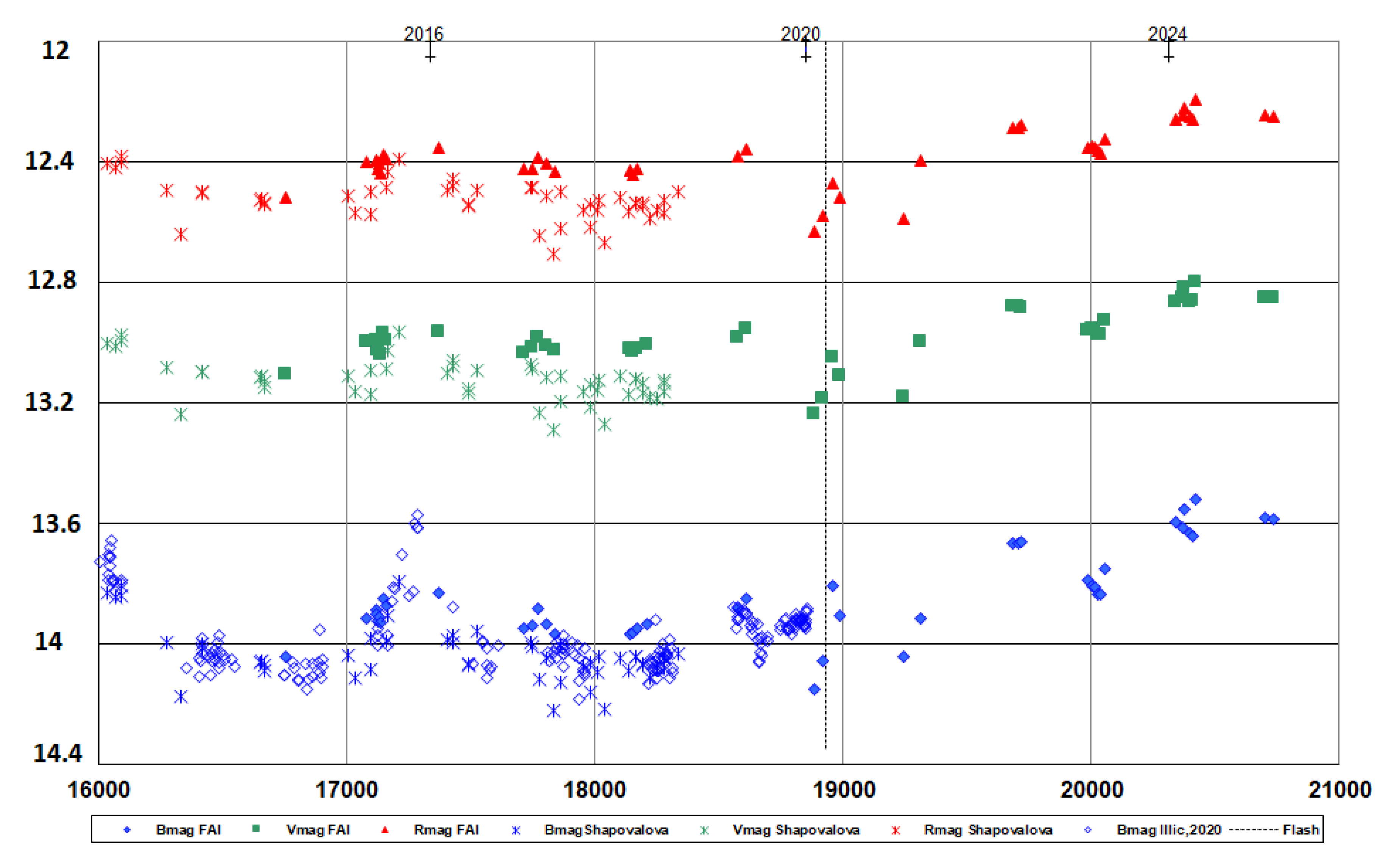
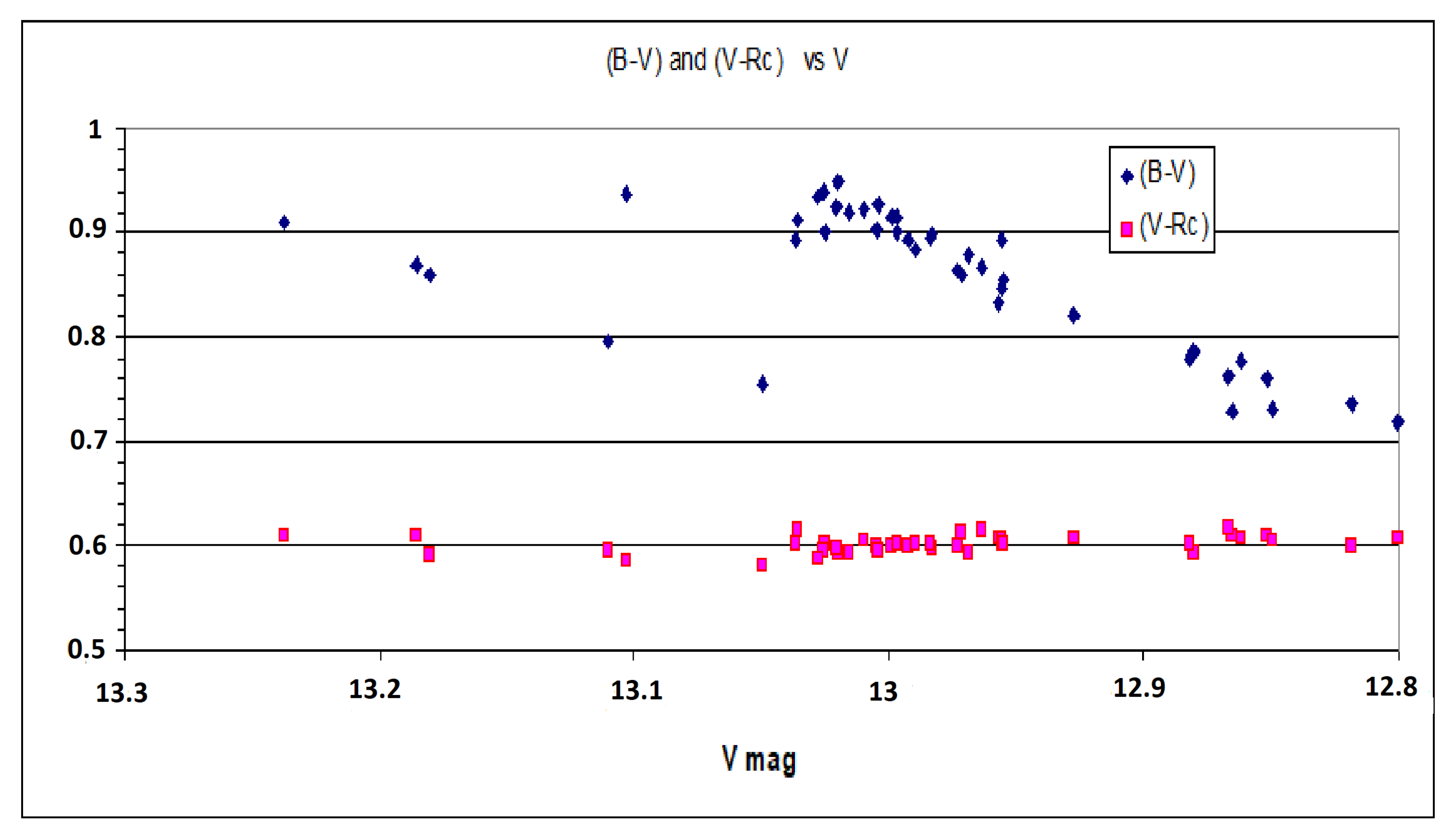
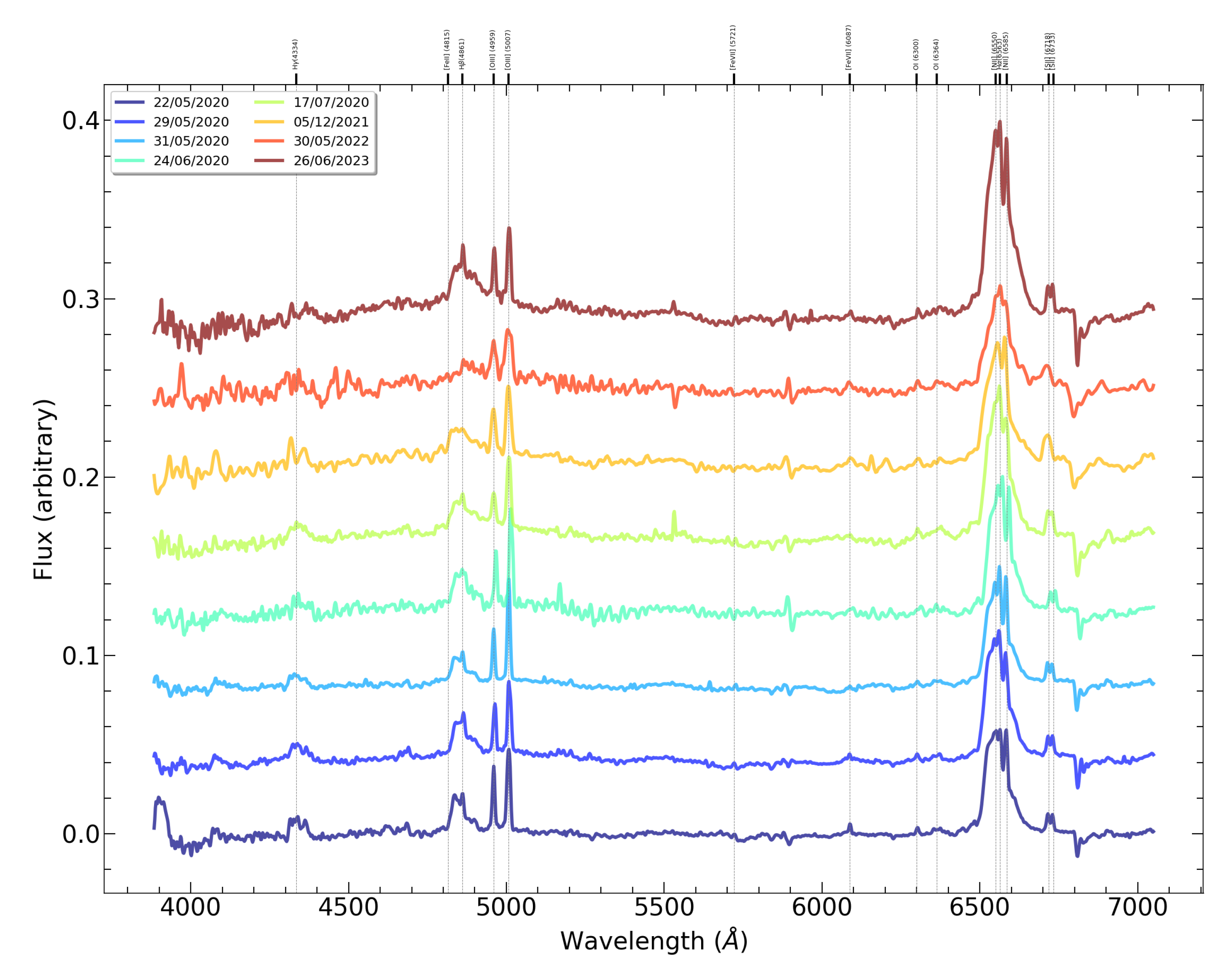
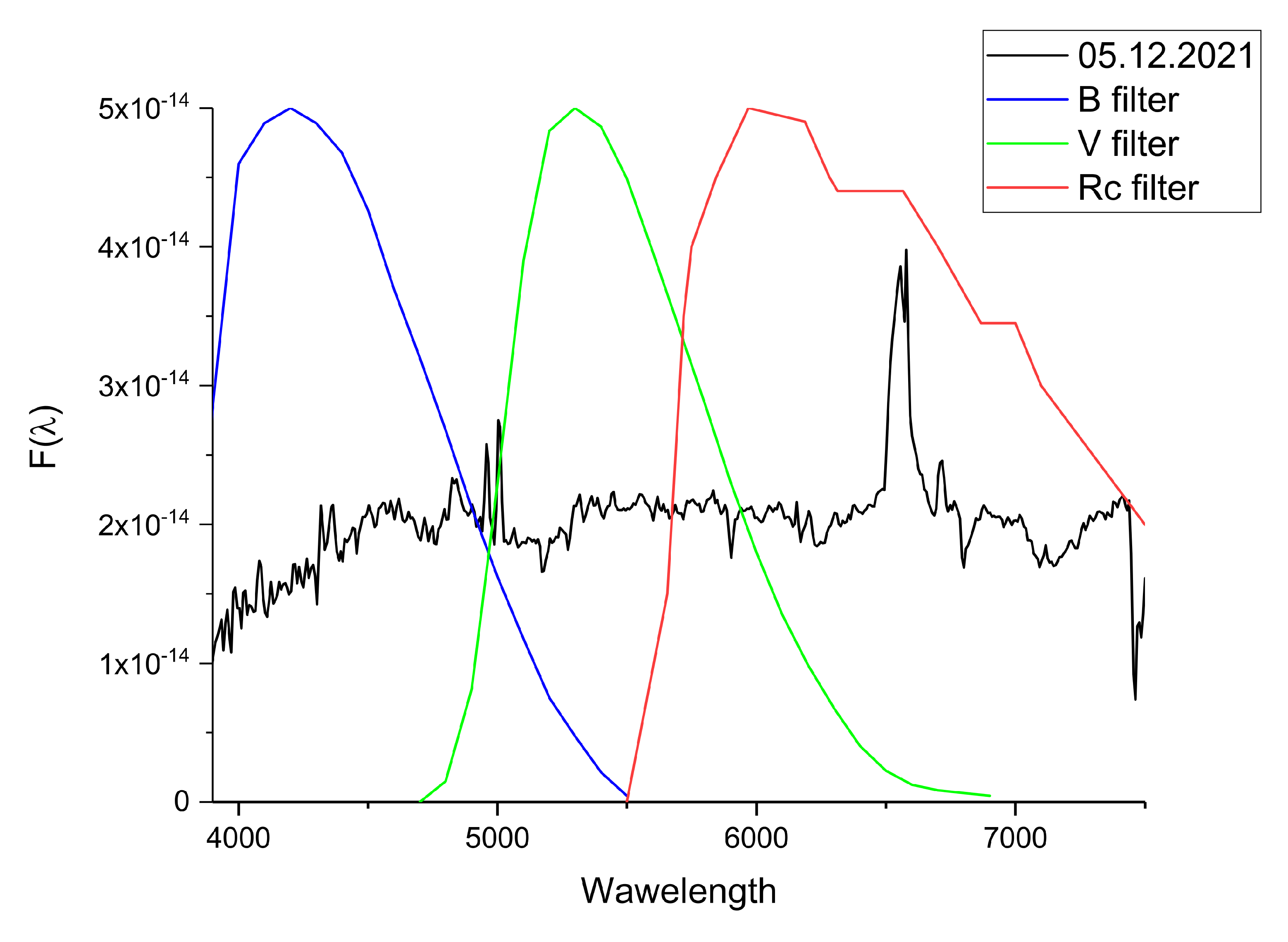
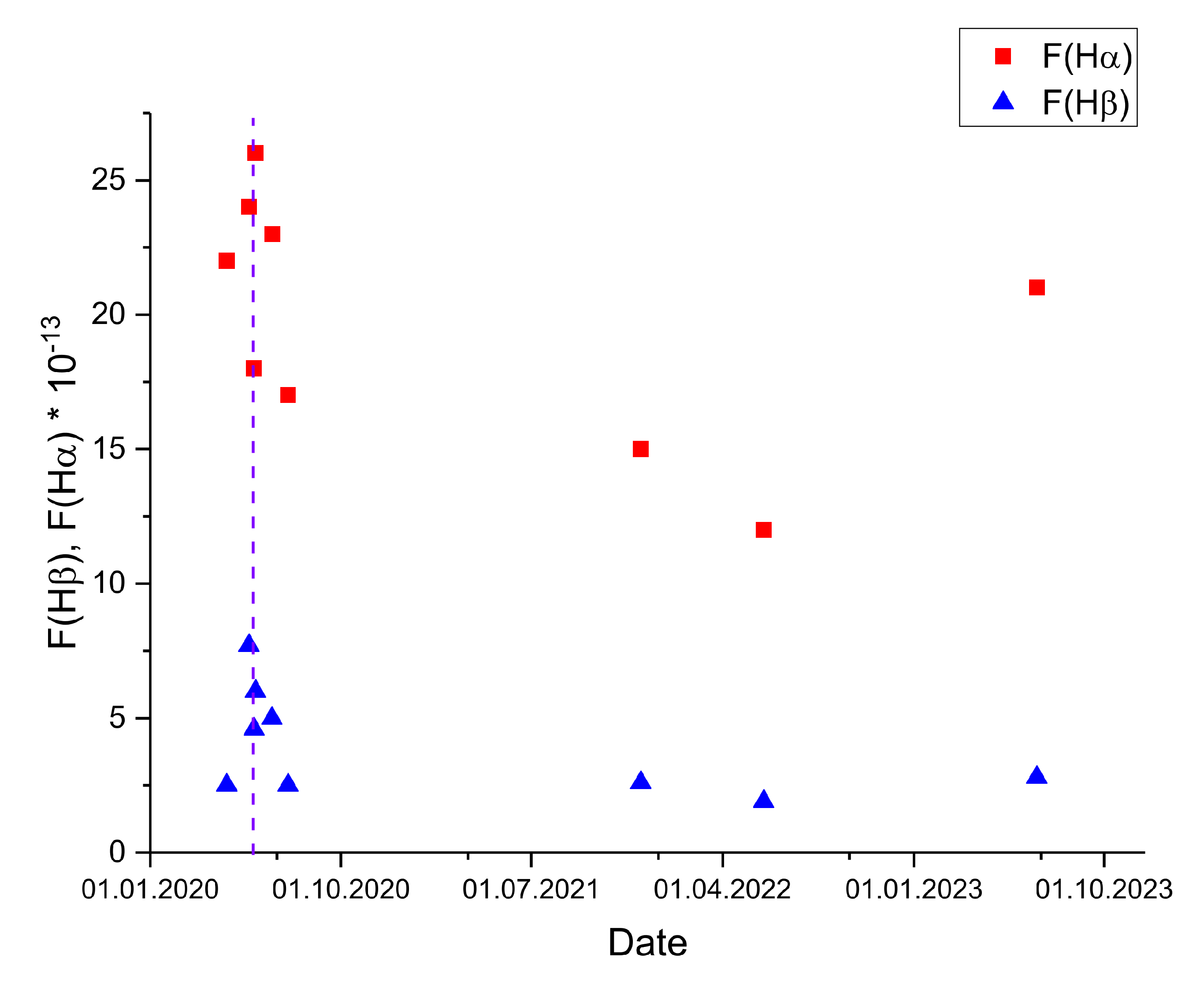
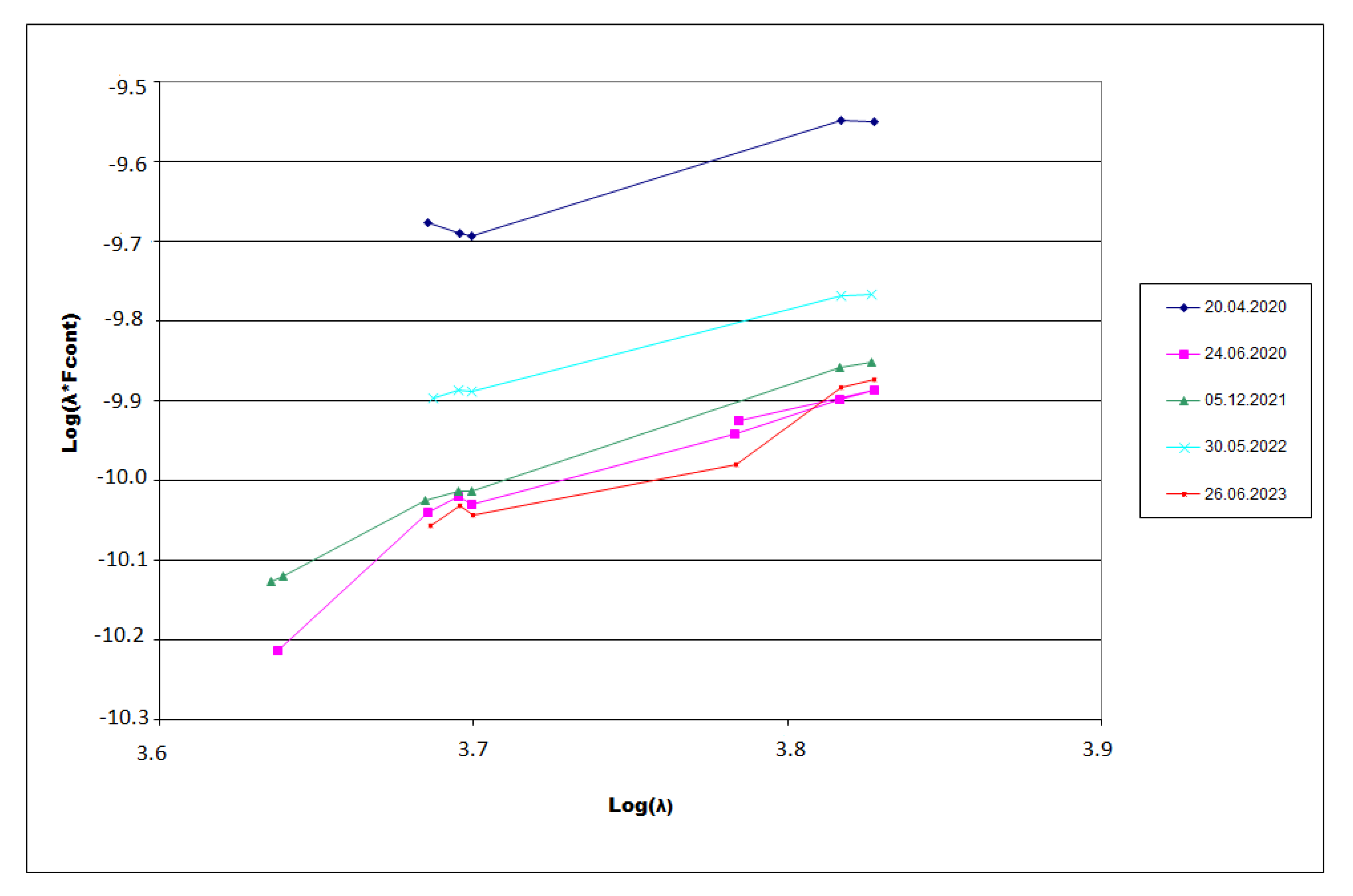
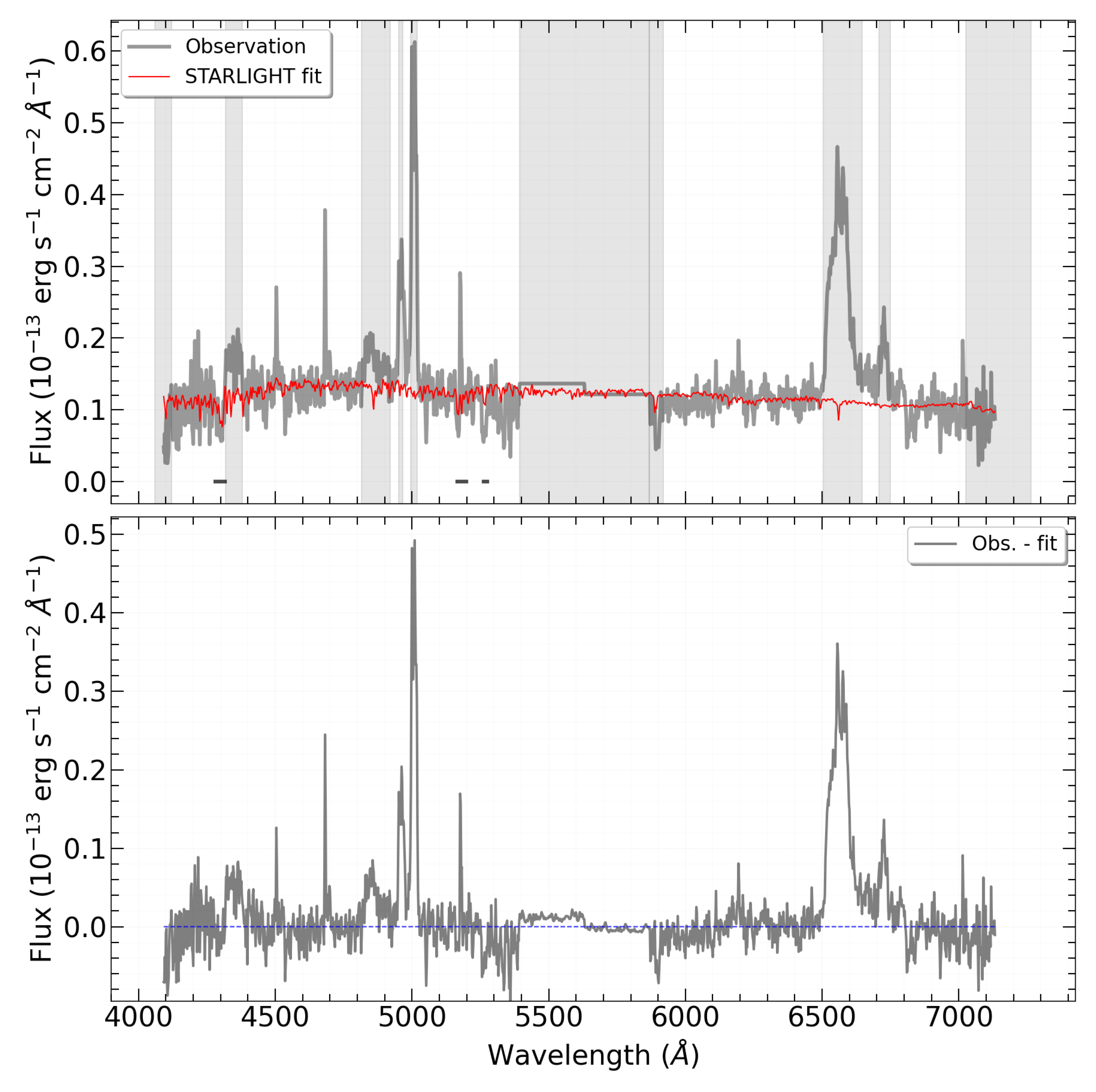
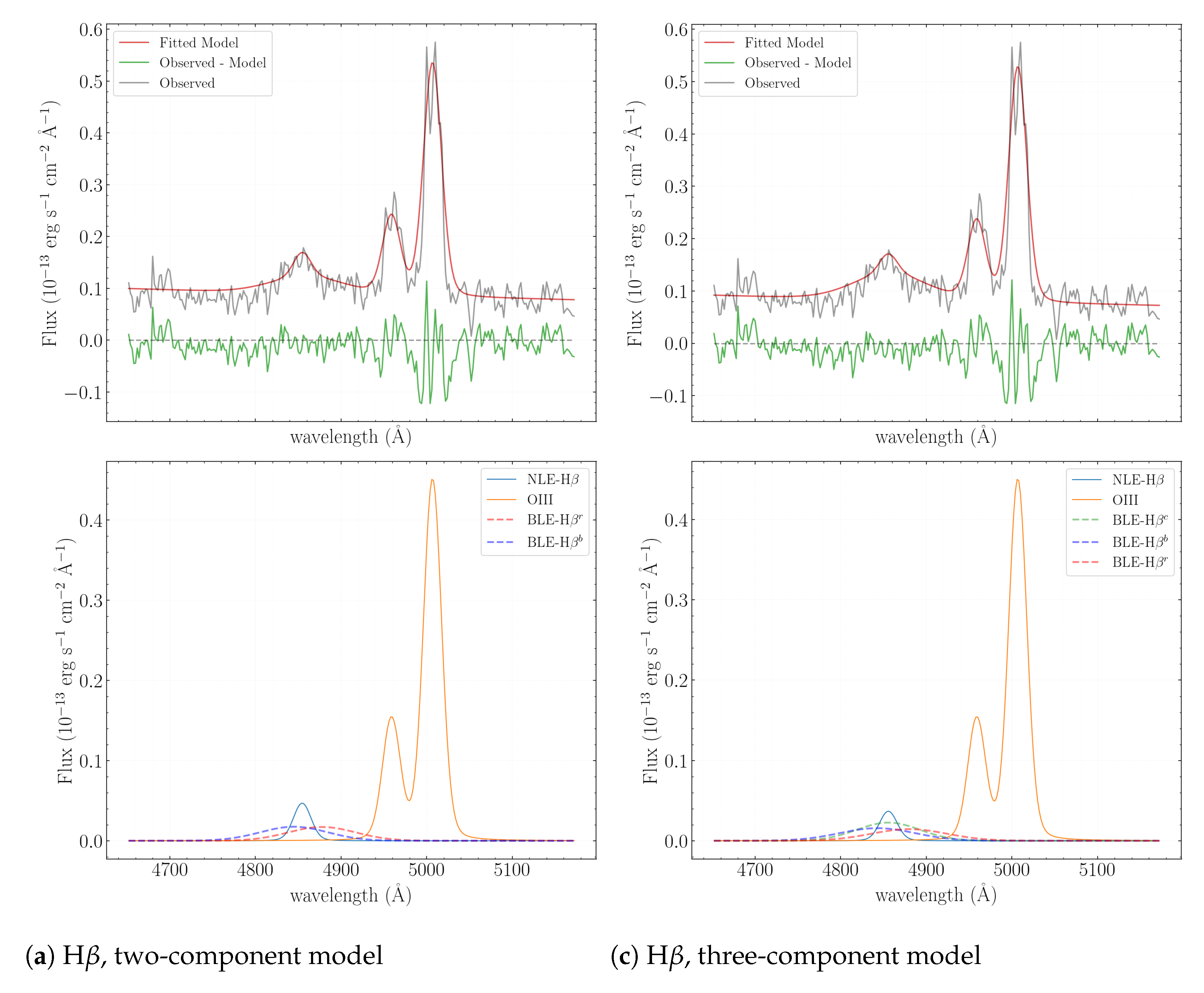
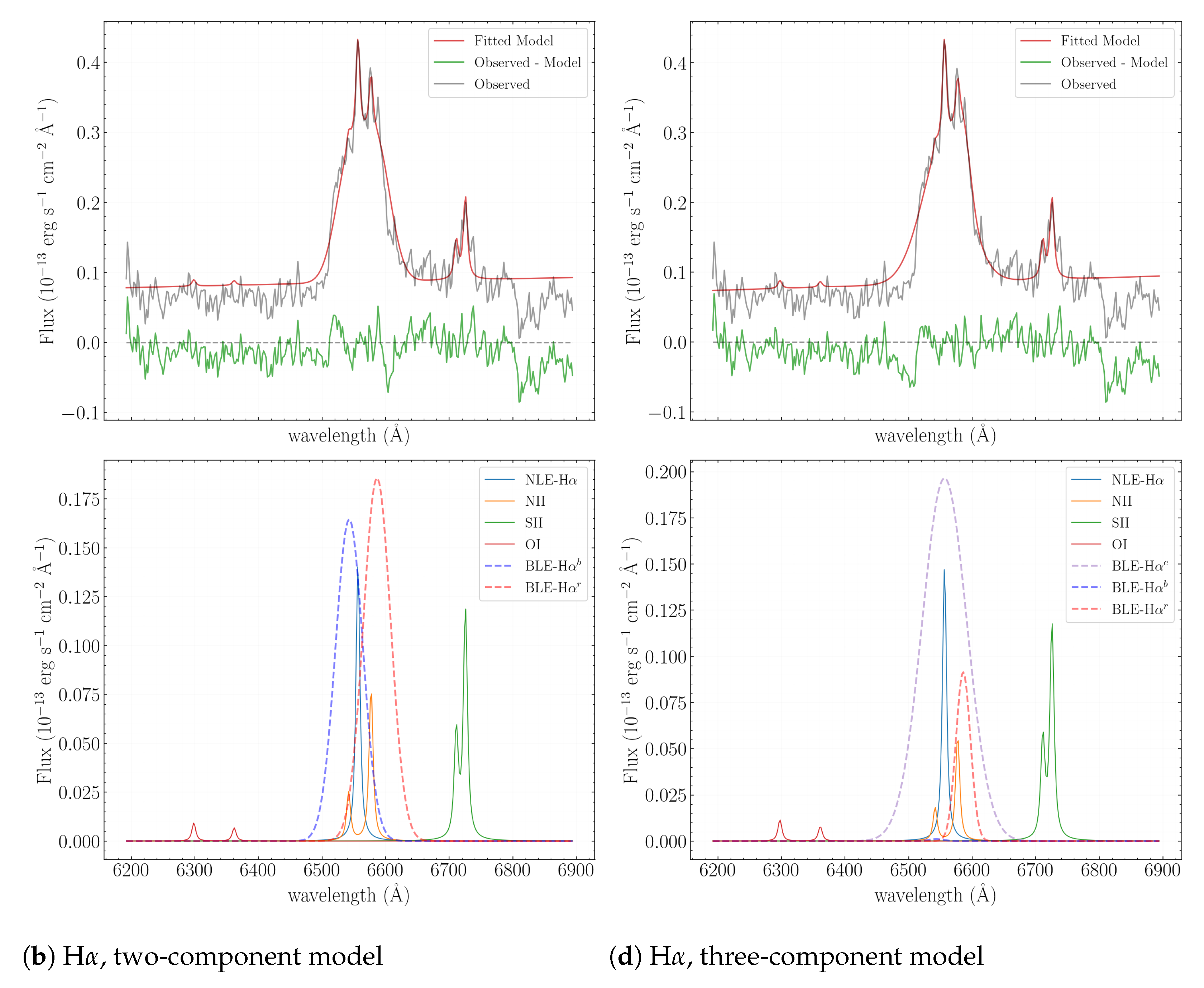
| Telescope 1 | Detector | Gratings | Tasks | Field of View | Location 2 |
|---|---|---|---|---|---|
| “East” Zeiss-1000 | CCD Apogee Alta U9000, filters | – | Photometry | TSHAO | |
| “West” Zeiss-1000 | CCD Apogee Alta U16M D9 | 300–2400 L/mm | Spectroscopy | TSHAO | |
| Zeiss-2000 | Andor, 2048 × 2048, 1 pix = 13.5 m | UAGS, F = 200 mm, f/2, D = 146 Å/mm | Spectroscopy | SHAO |
| Date | Line 1 | EQW | FWHM 2 | |||
|---|---|---|---|---|---|---|
| Å | Å | |||||
| 20 April 2020 | H | 6 ± 0.13 | 41 | |||
| [OIII] | 10 ± 0.39 | 23 | ||||
| [OIII] | 24 ± 1.08 | 20 | ||||
| H+[NII] | 50 ± 0.64 | 73 | ||||
| [SII] | 6 ± 0.21 | 25 | ||||
| 22 May 2020 | H | 62 | ||||
| H | 72 | |||||
| [OIII] | 10 | |||||
| [OIII] | 12 | |||||
| [FeVII] | 8 | |||||
| H+[NII] | 82 | |||||
| [SII] | 27 | |||||
| 29 May 2020 | H | 57 | ||||
| H | 77 | |||||
| [OIII] | 13 | |||||
| [OIII] | 11 | |||||
| [FeVII] | 29 | |||||
| H+[NII] | 83 | |||||
| [SII] | 31 | |||||
| 31 May 2020 | H | 67 | ||||
| H | 77 | |||||
| [OIII] | 10 | |||||
| [OIII] | 10 | |||||
| [FeVII] | 23 | |||||
| H+[NII] | 82 | |||||
| [SII] | 25 | |||||
| 24 June 2020 | H | 61 | ||||
| H | 75 | |||||
| [OIII] | 10 | |||||
| [OIII] | 12 | |||||
| [FeVII] | 17 | |||||
| H+[NII] | 82 | |||||
| [SII] | 25 | |||||
| 17 July 2020 | H | 52 | ||||
| H | 75 | |||||
| [OIII] | 19 | |||||
| [OIII] | 14 | |||||
| H+[NII] | 75 | |||||
| [SII] | 24 | |||||
| 05 Dec. 2021 | H | 27 | ||||
| H | 75 | |||||
| [OIII] | 15 | |||||
| [OIII] | 14 | |||||
| H+[NII] | 80 | |||||
| [SII] | 23 | |||||
| 30 May 2022 | H | 124 | ||||
| [OIII] | 19 | |||||
| [OIII] | 21 | |||||
| H+[NII] | 76 | |||||
| [SII] | 24 | |||||
| 26 June 2023 | H | 82 | ||||
| [OIII] | 11 | |||||
| [OIII] | 12 | |||||
| H+[NII] | 91 | |||||
| [SII] | 28 |
| Epoch | |||
|---|---|---|---|
| Date | Light-Days | ||
| 20 April 2020 | 0.20 | ||
| 22 May 2020 | 0.18 | ||
| 29 May 2020 | 0.14 | ||
| 31 May 2020 | 0.18 | ||
| 24 June 2020 | 0.14 | ||
| 17 July 2020 | 0.15 | ||
| 05 Dec. 2021 | 0.14 | ||
| 30 May 2022 | 0.16 | ||
| 26 June 2023 | 0.13 |
Disclaimer/Publisher’s Note: The statements, opinions and data contained in all publications are solely those of the individual author(s) and contributor(s) and not of MDPI and/or the editor(s). MDPI and/or the editor(s) disclaim responsibility for any injury to people or property resulting from any ideas, methods, instructions or products referred to in the content. |
© 2025 by the authors. Licensee MDPI, Basel, Switzerland. This article is an open access article distributed under the terms and conditions of the Creative Commons Attribution (CC BY) license (https://creativecommons.org/licenses/by/4.0/).
Share and Cite
Shomshekova, S.; Serebryanskiy, A.; Kondratyeva, L.; Huseynov, N.; Rahimli, S.; Kim, V.; Aktay, L.; Aimuratov, Y. Spectral and Photometric Studies of NGC 3516 in the Optical Range. Galaxies 2025, 13, 60. https://doi.org/10.3390/galaxies13030060
Shomshekova S, Serebryanskiy A, Kondratyeva L, Huseynov N, Rahimli S, Kim V, Aktay L, Aimuratov Y. Spectral and Photometric Studies of NGC 3516 in the Optical Range. Galaxies. 2025; 13(3):60. https://doi.org/10.3390/galaxies13030060
Chicago/Turabian StyleShomshekova, Saule, Alexander Serebryanskiy, Ludmila Kondratyeva, Nazim Huseynov, Samira Rahimli, Vitaliy Kim, Laura Aktay, and Yerlan Aimuratov. 2025. "Spectral and Photometric Studies of NGC 3516 in the Optical Range" Galaxies 13, no. 3: 60. https://doi.org/10.3390/galaxies13030060
APA StyleShomshekova, S., Serebryanskiy, A., Kondratyeva, L., Huseynov, N., Rahimli, S., Kim, V., Aktay, L., & Aimuratov, Y. (2025). Spectral and Photometric Studies of NGC 3516 in the Optical Range. Galaxies, 13(3), 60. https://doi.org/10.3390/galaxies13030060








